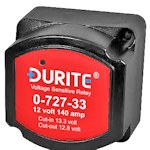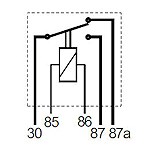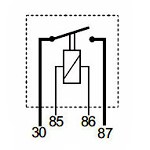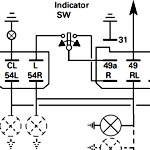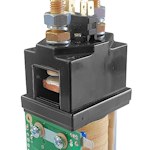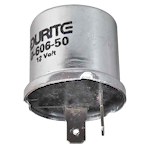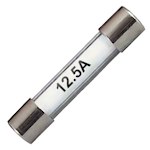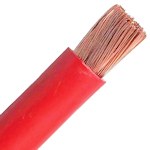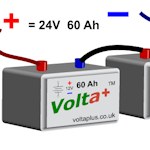Technical information Blogs for products supplied at ARC Components Limited. Helpful reference Blogs for electrical engineers and vehicle maintainers, with explanations of product characteristics, wiring guides, good practices and application of products.
14 November 2017 | AdrianR
The battery split charge relay supplied at Arc Components Limited is a high load intelligent voltage sensitive relay unit fitted between batteries for an efficient way of charging a secondary battery whilst not affecting the charge performance of the primary start battery. Designed for effective management of batteries and popular with the mobile home and marine communities, where the start battery charging takes priority, and once the charge level is up, the unit switches over to charge the leisure battery.
The Durite 0-727-33 12 Volts 140 Amps Voltage-sensitive relay allows the split charging of a second battery; without discharging the primary/start battery, the relay makes at 13.3 Volts and breaks at 12.8 Volts.
3 November 2017 | AdrianR
This post covers the changeover switch relays covered in the range of auto electrical products at Arc Components Limited. The relays supplied in-store are configured to DIN 72552 terminal standardisation.
Many configurations of a changeover relay are used for automotive electrical circuit switching, each allowing a variation on the switch operation; versions include Normally Closed (NC or active circuit), latching and coil suppression. One of these, the latching relay, allows a mechanical (or in some cases an electronic) function that retains the switched position even when power to the coil is cut; helpful in conserving power, the line switch is reactivated (usually with a momentary push switch) only when the coil is energised again.
3 November 2017 | AdrianR
This post covers the Make and Break switch relays covered in the range of auto electrical products at Arc Components Limited. The relays supplied in-store are configured to DIN 72552 terminal standardisation.
Many configurations of a Make and Break relays are used for automotive electrical circuit switching, each allowing a variation on the switch operation; versions include "Normally Open" (NO) or "Normally Closed" (NC) operation, fused and line suppression.
30 October 2017 | AdrianR
The standardisation definition guide is presented to identify pin-out configurations on automotive electrical components available at Arc-Components.com. DIN 72552 is used by most high-end component and vehicle manufacturers when creating an automotive circuit.
Examples of Pin-in and Pin-out DIN numbering can be found on Switch Relays, Key switches, Wiper motors, etc. This definition guide will assist engineers when replacing or renewing components and wiring, where a DIN code number system has been presented.
Albright coils in their contactors are wound with Pull-in and Drop-out voltages, variations of those features can be engineered to suit particular applications. You can use this blog post in conjunction with the Arc Components Ltd Product Files to identify a solenoid contactor best suited for your application.
Coil voltages ranging from 6 to 240V are available, which are wound for D.C. operation. However, the majority of coils can be factory fitted (via an enquiry) with a bridge rectifier for use with A.C. supplies. Coils are wound with Pull-in voltages (coils at 20°C) of approximately 66% of the rated voltage (Continuous) or 60% (Prolonged, Intermittent Or Very Intermittent), and Drop-out voltage nominally greater than 10% of the rated voltage. Variations of these Pull-in and Drop-out figures can be engineered to suit particular applications.
Many modern-day indicator flasher units available today can trigger a flashing circuit by pulse switching; old-style flasher units (like the Tin Can type) work differently and contain a bi-metallic strip. The strip comprises of two different conductive metals; riveted, brazed or welded together so that when a current is passed through, the two metals expand and contract at a different rate.
Often the cause of slow flashing or rapid flashing is the value of the current required to heat up and expand the metals. If you are a standard domestic motorist and your indicator flashing speed becomes erratic or slow, the recommendation is to get your vehicle checked out by a Professional. Causes can range from bulb failure (visually obvious or connection), cable problems (continuity), earth or ground joints and, in the case of additional trailer lighting, changing the characteristics of the circuit. One of the most common faults occurs when LED light bulbs (requiring less current) are replaced in the flasher circuit.
16 January 2017 | AdrianR
Modern fuses used in automotive and domestic applications now have (and should have) standardisation for fuse identification.
Current fuses in production standardise the displayed rating for "Continuous use", but in some cases, in particular glass fuses, the rating on the fuse cap can still be marked with a "Blow rating" in Amperage by manufacturers, which often leads to confusion even within the electrical trade.
4 December 2016 | AdrianR
The wiring guide presents two standard style caravan and trailer towing connectors configured in their historical terminal functions, the earlier 12N (Normal) ISO 1724 for essential lighting supply and the later 12S (Supplementary) ISO 3732 for extended auxiliary functions.
The two connectors used for lighting and auxiliary connectivity for trailers and caravans are joined in the extensive range of power products by a modern 13-pin connector solution.
2 November 2016 | AdrianR
This post is dedicated to an acknowledgement that due to a modern world of information technology and supply chain, circumstances dictate the need to convert wire sizes into a format understandable to a broader global community of mechanical and electrical engineers, specifically for products not purchased from Arc Components Limited, usually that require additional fittings and components that adhere to the UK and metric standards.
While the necessary wiring and cable load values must always be sought for the job in hand, whether for trade, project or DIY applications, there is a need, in the name of service, to assist engineers presented with "Country Specific" product information.
2 November 2016 | AdrianR
A historical blog post revisited. The original blog post became an important feature that tried to address bad practices, particularly within the mobile home and boating communities, highlighting the common misunderstandings of battery connectivity.
One of the frequent questions to our help desk at Arc Components Limited is about batteries linked in Series and Parallel and the effect of voltage and amperage output. To help, we created a simple guide to show the cause and effect of batteries joined together to form battery banks.
